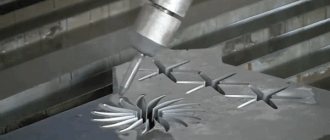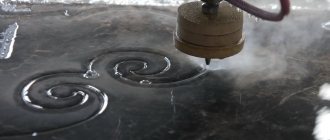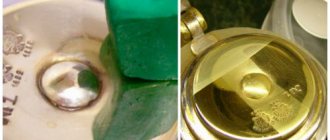Water jet (water sand blasting) cleaning in
Hydroabrasive cleaning is a jet cleaning technology for industrial cleaning, in which the carrier media that provide the impact on the surface are water and abrasive.
Waterjet cleaning can also be pneumohydroabrasive (aerohydrodynamic, aerohydroabrasive) cleaning, since the waterjet mixture is supplied to the surface using compressed air. Water jet cleaning is used in a wide range of activities to remove contaminants, prepare steel structures for painting: imparting the necessary roughness, removing scale, rust, old paint and other coatings.
During the formation of a water-abrasive mixture, abrasive particles are enveloped in water, which increases the weight of the granule and, accordingly, increases the collision of the abrasive with the surface being cleaned, providing a powerful effect of separating contamination from the surface without damaging the surface itself due to the fact that upon impact, the water shell of the abrasive is the first to contact. After the impact of an abrasive particle creates a crack in the contamination, the water component of the mixture penetrates under the layer of contamination, removing it from the inside. This physics of the process not only allows you to effectively clean the surface, but also prevents wear of the complex elements: nozzles and hoses.
Metal structures
This method of removing corrosive formations, for example, rust, is used in cases where conventional methods cannot achieve the desired result. For example, dry cleaning on metal structures is ineffective.
But, if removing contaminants does not allow removing the necessary layers, then water with the addition of abrasive particles is used. Due to the fact that cleaning the metal can be difficult because it can be subject to corrosion, a hydro jet with the addition of sand is used.
Technological diagrams of waterjet cleaning complexes
1. Hydropneumatic abrasive (aerohydroabrasive, aerohydrodynamic) cleaning, which requires the presence of a source of compressed air.
2. Water jet cleaning using injection method
If you are interested in carrying out work using waterjet cleaning technology, fill out an application for work or contact us by phone.
Washing plastic facades
When washing plastic surfaces, you should follow certain recommendations:
- If there are cracks or chips in the plastic, then it is better to treat these areas manually rather than under water pressure.
- Façade detergents should not contain aggressive chemicals. As a rule, dirt can be removed using regular liquid soap.
- When using mini-sinks, do not press the brush too hard - the material may bend. In addition, if the plastic is installed vertically, then the liquid should flow from top to bottom, that is, along the joints, and not across them, in order to prevent moisture from entering the structure.
Source
Water jet cleaning
Currently, there are several ways to clean metal surfaces. Each of them has a number of advantages, as well as disadvantages. When using some of them, the question arises about the environmental friendliness of the process and how to dispose of the remaining waste. Many people use abrasive blasting, shot blasting, ultrasonic treatment, high-pressure water cleaning, acid etching, but none of the above methods combines the three main requirements - productivity, ecology, quality. As a rule, priority is given to productivity rather than environmental friendliness of the process.
The hydroabrasive cleaning method has been known for quite some time. It was first used in the 60s, but for a long time did not receive proper support as it was difficult to implement in metal. The widespread use of the waterjet treatment method began several years ago. Recently, it has been actively used in European countries, the USA, and also in Russia. It is used where speed, quality, environmental friendliness and safety are required.
Waterjet treatment is used to clean the surfaces of blades of unmanned vehicles, turbines, and aircraft engines from rust, paint and scale. The waterjet cleaning method allows you to achieve the highest degree of Sa3. According to the standards of the Swedish Standards Association, this is finishing to a clean surface. As a result, the metal should not contain any types of contaminants and have a characteristic gray-white tint and slight relief.
Before starting work, specialists assess the degree of surface contamination: A – a significant part of the surface is covered with scale, but there is no rust or is present in small quantities. B – the metal surface is rusty and has begun to peel off in some places. C – the metal surface is completely covered with rust, but it can be scraped off. At the same time, there are small indentations on it. D – the metal surface is completely rusty; small holes can be seen with the naked eye.
According to existing waterjet treatment schemes, the following are distinguished:
- Water jetting with high water pressure. Cleaning in this way is ensured by the presence of an installation that supplies a water jet at a pressure of up to 3000 Bar and a sandblasting machine with a compressor that creates a pressure of up to 12 Bar. In this case, the abrasive must be dry, homogeneous fraction. Mixing water with abrasive takes place in a special tank of a combined nozzle. The result is a water jet with abrasive under very high pressure. At the moment, there are few such installations in Russia, but it is in the arsenal.
- Waterjet machining with low water pressure. A similar cleaning method is provided by a water jet with an abrasive under a pressure of 12 bar. Water is supplied to a special section of the sprayer, which is attached to the sandblasting nozzle. During operation, water is injected, and abrasive and water are mixed at the outlet of the installation.
Areas of use
The use of hydro-jet cleaning is carried out at many facilities not only of industrial importance, namely:
- Removing contaminants from building facades using high-pressure units. Its special feature is that you can easily clean decorative elements and construction joints on construction sites. In addition, you can easily remove old plaster without causing damage to the structure.
- It is also very often used for cleaning metal structures that contain bitumen, rust and scale, without damaging the structure of the material.
- The pipelines are cleaned of possible deposits inside the pipe, as a result the inside becomes clean.
- Removal of rubber and road markings from the road is carried out using hydro-blasting equipment, which is much more effective than using a sandblasting device.
- This is how the hulls of ships, sea and river transport are cleaned.
Pneumatic water jet machining
Pneumatic waterjet treatment is used to clean the surface of carbon deposits, rust, scale, and paint. Thanks to its use, it is possible to achieve a reduction in roughness and matting. There are small-sized chambers for pneumatic waterjet processing. Their purpose, in addition to the above, also includes: cleaning small-sized products, matting parts of optical devices, plasma spraying, galvanizing, galvanizing. In some cases, open-type pneumatic waterjet units can also be used. Such a device combines the functions of a stationary and mobile device. Thanks to the environmentally friendly cleaning method, it can be used in closed workshops with a temperature of at least 4°C. Separately, it is worth highlighting automatic installations for pneumatic waterjet cleaning. Depending on the surface being treated, they have several types:
- For cleaning turbine blades. In order to process them efficiently, the operator first traces the surface with a laser beam. The automatic system remembers and repeats the trajectory of movement, regulates the stroke of the blade and jet apparatus. This ensures high-quality cleaning of the entire surface. The stages of the processing process can be seen on the graphic display. Such a system can be equipped with measuring instruments that scan the initial and final results and issue them in printed form.
- Installation for cleaning titanium profiles. It removes organic and inorganic deposits and scale from their surface.
- Installation for cleaning pipe sections. With its help you can get rid of scale, soot, rust, oxide, organic and inorganic contaminants. This installation will ensure minimal impact on the object being cleaned.
- Apparatus for cleaning wheelsets. It is designed for processing the axle, outer and inner rim parts.
- Installation for cleaning wire and rolled products. With its help you can get rid of oxide films, scale, soot, rust, organic and inorganic deposits. This installation is used to prepare rolled products for cold deformation.
- Installation for sheet processing. It is designed to clean titanium sheets from process contaminants and scale.
Advantages and disadvantages
Due to the fact that hydrojet is used at high pressure, surface cleaning is considered one of the effective ways to remove any contaminants. Among the many advantages, the following stand out:
- One of its main advantages is its absolute environmental friendliness, since ordinary water is used.
- The execution process is quite fast, and at the same time it is not expensive. The price of such work is much cheaper than processing with other cleaning methods.
- In addition, with this method the industrial process does not stop, so owners of large enterprises do not suffer losses.
- Easy to use, since the hydraulic jet device is quite maneuverable and mobile, which makes work easier.
- High guarantee of cleaning of any surfaces.
- An important point is safety, especially with regard to explosion hazards and fire safety of cleaned objects.
As for the disadvantages, it is that this equipment cannot be used at low temperatures. But today, thanks to new technologies, it is possible to use this equipment in the cold season.
Video: hydro-jet cleaning of metal.
Advantages of waterjet cleaning:
- Maintaining the initial level of surface roughness and shape.
- Ability to process openwork and thin devices.
- No removal of the main metal surface.
- Impossibility for abrasive to penetrate into the internal structure of the surface.
- Elimination of corrosion sites.
- Possibility of subsequent flaw detection.
- The ability to add special agents during the cleaning process to prevent the reappearance of corrosion centers.
- Environmental friendliness of the method: all abrasives have hygienic certificates.
- No dust during processing.
- Compatible with existing production processes.
- The use of inexpensive and accessible raw materials, the possibility of reusing abrasives, which leads to a reduction in the cost of the entire process.
- No requirements for water preparation.
- Explosion and fire safety











